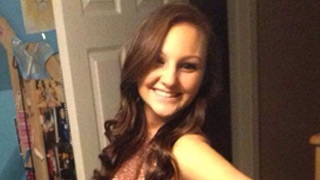A lump in Felicia's neck led to an unexpected diagnosis.
 Felicia thought her long battle with cancer was finally over. After being diagnosed with Wilms’ tumor at age 6 and undergoing years of treatment at The Children’s Hospital of Philadelphia — radiation, chemotherapy and eight surgeries — she had finally been declared cancer-free in 2010.
Felicia thought her long battle with cancer was finally over. After being diagnosed with Wilms’ tumor at age 6 and undergoing years of treatment at The Children’s Hospital of Philadelphia — radiation, chemotherapy and eight surgeries — she had finally been declared cancer-free in 2010.
But in late 2014, when Felicia was in her sophomore year of college, she found herself back at CHOP, this time with a new diagnosis: thyroid cancer.
Care from a multidisciplinary team
When Felicia first noticed the lump on her neck, she thought it was a swollen lymph node — she had a bad case of poison ivy at the time, and it’s not uncommon for nearby lymph nodes to swell in such situations. But when the lump didn’t go away, Felicia asked the Cancer Survivorship team at CHOP, whom she still saw regularly for checkups, to take a look.
After Jill P. Ginsberg, MD, director of the Cancer Survivorship Program, felt the lump on Felicia’s neck, she arranged for Felicia to have a thyroid ultrasound — and then to see Goli Mostoufi-Moab, MD, MSCE, a pediatric oncologist and endocrinologist who is part of the Cancer Survivorship team and the Thyroid Center at CHOP.
A few weeks later, Felicia learned that she had papillary thyroid cancer, the most common type of thyroid cancer — and one of the most curable.
Surgery and radioactive iodine ablation
Endocrine disorders are among the most common issues facing childhood cancer survivors. CHOP’s Cancer Survivorship Program brings together specialists from many disciplines to provide follow-up and screening for these patients, whose past cancer therapy places them at increased risk for certain health problems. Because the team knew Felicia’s health history so well, they were able to make a diagnosis quickly — and Felicia was able to begin treatment as soon as possible.
The first step in Felicia’s treatment plan was surgery to remove her thyroid — a procedure called a total thyroidectomy. It’s an extremely challenging surgery, but Felicia knew she was in excellent hands: her surgeon, N. Scott Adzick, MD, had performed all but one of her previous surgeries and knew Felicia and her family well. Dr. Adzick also has extensive experience with the procedure. Between 70 and 80 thyroid surgeries are performed at CHOP each year, and about half of those are for thyroid cancer or thyroid nodules.
Six weeks after the surgery, Felicia began the next phase of her treatment: radioactive iodine ablation, which aims to eliminate any remaining thyroid cells. The therapy involves several steps and a series of outpatient visits, but Felicia’s team worked together to make the experience as easy for her as possible. As Felicia’s main physician, Dr. Mostoufi-Moab coordinated all the details, gathered updates from all of the specialists involved in Felicia’s care, and made sure that Felicia’s treatment plan worked with her school schedule.
Having one physician who serves as “common ground” for the patient is a cornerstone of the family-centered care the center provides. “It’s like having a captain of the ship who organizes things behind the scenes,” Dr. Mostoufi-Moab says.
Looking ahead
Now a sophomore at La Salle University, Felicia plans to continue her studies after graduation and become a doctor or a physician assistant. She takes thyroid hormone replacement medication every day and sees Dr. Mostoufi-Moab regularly for follow-up. In the next few years, she’ll transition her care to adult providers – but she’ll never forget the amazing team at CHOP.
“As a young child and a young adult, I was still able to go to school, hang with my friends, and do whatever I wanted while still receiving the care and treatments I needed,” she says. “My team at CHOP has always catered to me and has never let my illness take over my life.”